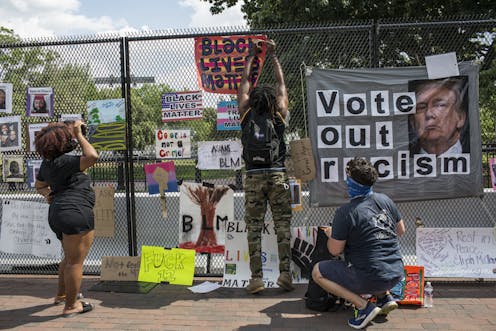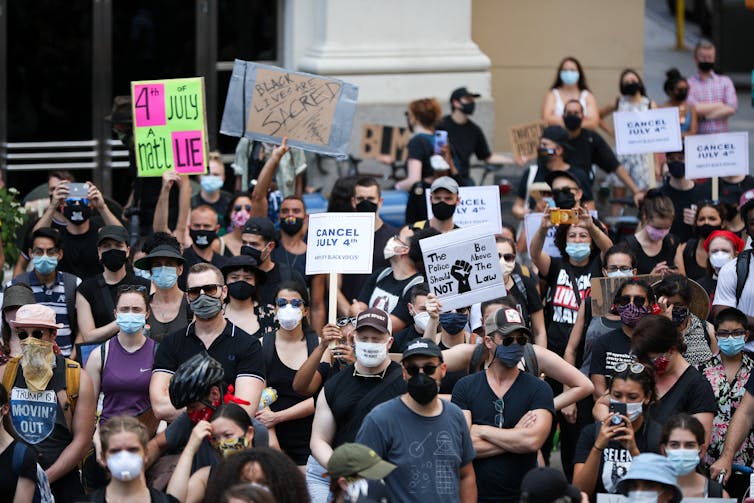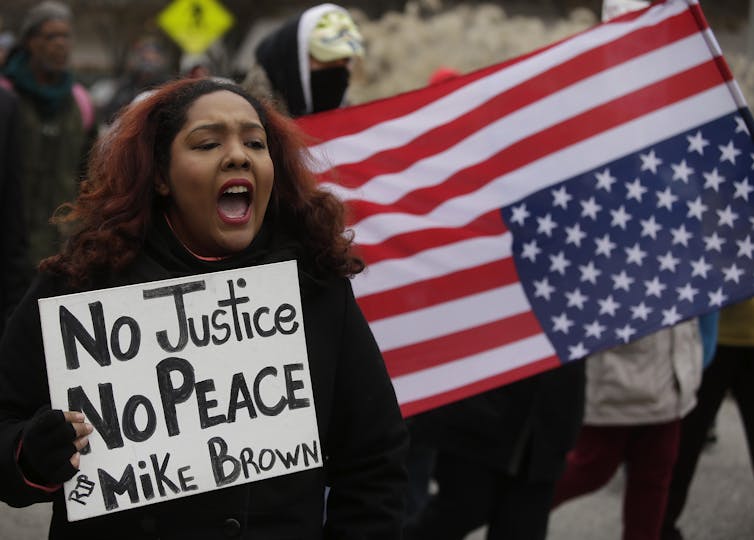When the world changes under a political scientist's feet
A political scientist says the protests against police violence that have swept the US signal welcome social change -- and could dramatically alter the work she's done for five years.

The scientific method isn’t easy to use during rapid social change.
Protests in response to George Floyd’s death spread to over 2,000 cities and towns across the U.S. People of all backgrounds are participating in this national uprising, demanding an end to racist policing.
As a political scientist, I investigate why police killings lead to protest. It is thrilling to watch this movement spark much-needed debates about race and policing.
Yet, because of the uprising, I am now facing a challenge that few political scientists ever do. Normally, the outcomes and causal factors that most political scientists study change slowly, over time.
Now, the protests I study have skyrocketed in number and participants. The beliefs I hypothesized were driving them could be changing as well. As more people join the protests and update their beliefs about race, the hypotheses I was planning to test could become outdated.
I am simultaneously watching welcome social change unfold, and watching events that could dramatically alter the work I’ve done for the last five years.

Theory, test, adjust theory
Why does one police killing inspire a protest, but another killing does not?
I was moved to research this topic following the 2014 police shooting of Michael Brown and the subsequent uprising in Ferguson, Missouri. A Ph.D. student at Stanford University at the time, I wanted to understand when and why communities resist police violence.
When you use the scientific method in the social sciences, you begin by developing a hypothesis – an informed prediction about the answer to your research question. So I started with a hypothesis that the circumstances of a police killing would determine people’s willingness to protest. For example, I believed people would be instantly outraged by the shooting of an unarmed youth but not be stirred to act if the person killed were accused of a violent crime.
Then you test your hypothesis by observing patterns in data and behavior.
The data I collected on the circumstances of police killings did not support this hypothesis. I also discovered through interviews that even longtime police-reform activists could react to the same killing in very different ways. So I had to adjust my theory.
Now, part of my research examines how people’s preexisting beliefs and attitudes shape the way they interpret violent police incidents.
[Deep knowledge, daily. Sign up for The Conversation’s newsletter.]
Attitudes about race, specifically, color these interpretations. In a working paper with my co-author, political scientist Mackenzie Israel-Trummel, we find through a survey experiment that people’s beliefs about the causes of racial inequality influenced whether they thought a detainee deserved to be beaten.
Respondents who recognized the role of structural racism in racial inequality were less likely to think the beating was deserved. Those who attributed inequality to the perceived individual failings of Blacks were more likely to blame the victim.
Before the recent protests erupted, in order to find out how these beliefs relate to the likelihood of protest, I was planning to test how these two views of inequality and structural racism correlated with actual racial and geographic patterns of protest following police killings.
I collected new data on which police killings led to protest in 2015 and 2016. My preliminary analyses reveal large variation in protest based on the race of the person killed and the region of the country. The killings of African Americans are seven times more likely to spark demonstrations than the killings of whites. Even comparing within race, African American communities in certain cities are quick to protest any lethal incidents while Blacks in other towns remain quiet.
If white and Black Americans have different attitudes about structural racism in different parts of the country, this could partially explain variation in willingness to protest police killings locally.

Throw away theory?
My research was proceeding in orderly fashion until the end of May of this year, when protests against police violence broke out across the country.
These protests and the growing movement around them provide clues that the very attitudes I was studying are changing rapidly following George Floyd’s death. Books about systemic racism are now topping bestseller lists. Recent polls have reported a dramatic shift in attitudes, as nearly half of Americans report that police violence is a serious problem in the U.S., up from only one-third who believed that in 2015.
The causal story I predicted – that attitudes about structural racism would drive protests – seems to have almost reversed: The protests themselves seem to be driving a shift in people’s views of structural racism and systemic problems in policing.
On top of it all, these shifts could be narrowing the racial and geographic divides I had seen before.
Previously, I saw very few protests about police violence in majority-white areas or in conservative regions of the country. Though exact numbers are unknown, it seems that more whites are joining these Black Lives Matter protests than ever before, possibly narrowing the documented racial divide in attitudes about police violence. The demonstrations have spread all over the country, even into small towns and white-majority suburbs that have not protested police violence in the past.
Welcome change makes research harder (but worth it)
As more and more Americans join protests and learn about structural racism and systemic police abuses, this could significantly change the way they perceive and respond to police violence in the future.
Will this shift in attitudes be long-lasting or temporary? Though my research would be simpler in a pre-2020 world, I sincerely hope these changes are long-lasting.
Since the upheaval is still ongoing, I must wait to test my theory. If I were to run the study now and find no support for my hypothesis, I would have no way of knowing whether I was wrong to begin with, whether this wave of protest has fundamentally changed the racial landscape of people’s attitudes about the police or whether this change is only temporary.
However, this delay is a worthy price to pay for more accurate research in the service of racial justice and police accountability. For now, I will keep my feet in the streets and an eye on the polls to determine whether it is the right time to run the study – or time to build a new theory for 2020 and beyond.
Shea Streeter does not work for, consult, own shares in or receive funding from any company or organization that would benefit from this article, and has disclosed no relevant affiliations beyond their academic appointment.
Read These Next
Deception and lies from the White House to justify a war in Venezuela? We’ve seen this movie before
Two US wars based on lies, in which tens of thousands of American troops and millions of civilians died,…
Miami’s new mayor faces a housing affordability crisis, city charter reform and a shrinking budget
Eileen Higgins won a hard-fought election to become Miami’s new mayor. Now for the hard part – governing…
Understanding climate change in America: Skepticism, dogmatism and personal experience
Real skeptics study the evidence and ask questions, rather than taking political dogma on faith. Experiencing…






